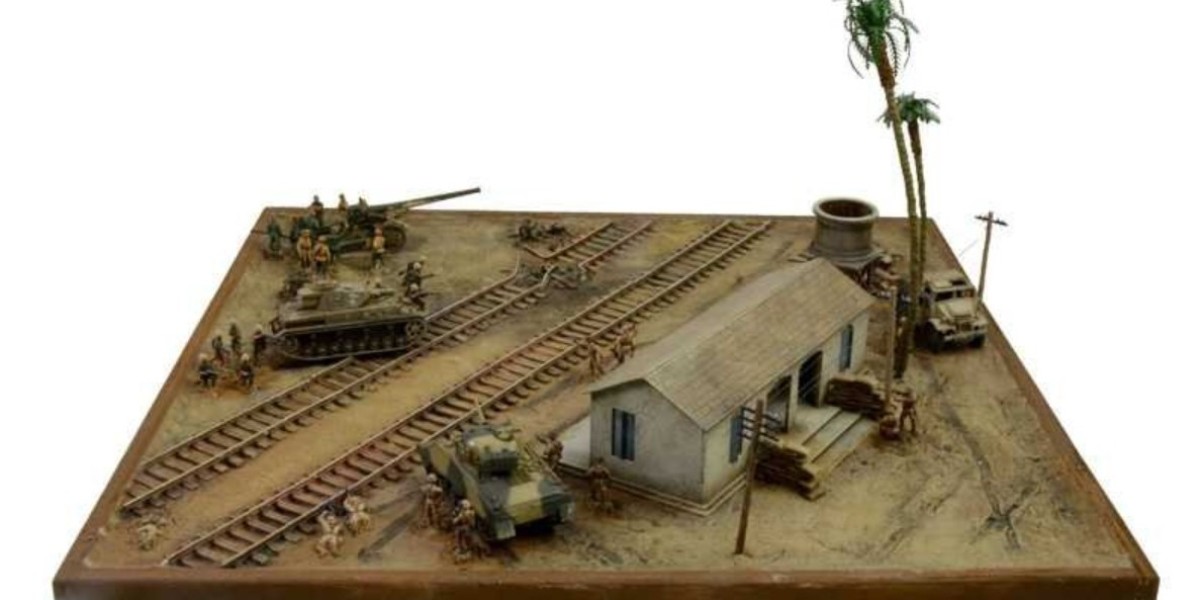Introduction: Elevating Your Diorama with Realism
Building dioramas is an art form that allows you to recreate miniature worlds. Whether you're depicting a historic battle, a bustling city street, or a fantasy landscape, adding realistic details can elevate your diorama from a simple model kit to a true masterpiece. Realism in a diorama brings the scene to life, making it feel immersive and believable.
At Plastic-Models-Store.com, we offer high-quality diorama kits and accessories from leading brands such as MiniArt, ICM, and Roden. These kits provide the foundation, but it’s the details that make your diorama unique. In this guide, we’ll explore the best techniques for adding realistic details to your diorama kit scenes.
1. Planning Your Scene for Maximum Realism
Before diving into the details, the first step is to plan your scene carefully. Ask yourself these key questions:
- What story are you trying to tell?
- What is the time period or setting of your diorama?
- What kind of weather or environment will you depict?
Having a clear vision of your scene helps you choose the right elements to add and ensures consistency across all details.
Tip: Observe Real Life
The most realistic dioramas are based on real-world observations. Look at photos, visit museums, or even examine your surroundings to get a sense of how things age, decay, or interact with their environment. If you’re modeling a wartime scene, study photos of battlefields and military vehicles to capture the wear, tear, and weathering effects accurately.
2. Realistic Weathering Effects for Added Depth
Weathering is one of the most effective ways to add realism to your diorama. Real-world objects are rarely pristine, especially in environments like battlefields or industrial settings. Adding weathering effects gives your diorama the appearance of wear, age, and exposure to the elements.
Techniques for Weathering:
- Dry Brushing: This involves lightly brushing paint onto raised surfaces to highlight textures like rust, dust, or dirt. It’s great for making edges and surfaces look worn.
- Washes: Thin, diluted paint can be applied over surfaces to create shadows, grime, and dirt accumulation in crevices.
- Chipping: Use a sponge or small brush to apply metallic or rust-colored paint in small spots, mimicking paint chipping off vehicles or buildings.
- Rust Effects: You can create rust by using special pigments or paint designed to replicate the look of corroded metal. It works well on military vehicles, old buildings, and machinery.
By adding these weathering effects, you can make items like tanks, trucks, and ruins look as though they've been through real battles or weathered harsh environments.
3. Using Texture for Ground and Terrain
The terrain is the foundation of your diorama, and the texture of the ground can greatly influence the overall realism of your scene. Whether you're depicting muddy battlefields, dusty desert landscapes, or overgrown forests, getting the texture right is key.
How to Create Realistic Terrain:
- Use plaster or modeling clay to shape hills, valleys, or craters. These materials are easy to mold and can form the base for your terrain.
- Add texture by sprinkling fine gravel, sand, or dirt onto the surface. Static grass and flocking can simulate grass, moss, or shrubs, adding natural texture to fields or forest scenes.
- For water features like rivers or puddles, use resin or gloss medium to create clear, realistic water effects. Small waves or ripples can be created by manipulating the resin while it's drying.
If you're building a military diorama, consider adding tank tracks or footprints in the mud to suggest recent movement through the scene. This small detail can instantly add a sense of realism and activity.
4. Adding Small-Scale Objects for Realism
Small objects scattered throughout your diorama can tell the story of your scene. These objects, often called scatter items, bring a sense of life and use to your environment. You can either purchase small-scale objects or create them from scratch using basic materials.
Examples of Realistic Small-Scale Objects:
- Barrels, crates, or boxes: These are common in both military and civilian dioramas. You can weather them with dirt, rust, or scratches to make them look old and used.
- Personal items: For scenes involving soldiers or civilians, small details like helmets, bags, or weapons can give your figures more personality.
- Urban details: In cityscapes, adding things like street signs, lampposts, or broken windows can significantly enhance the realism.
These small details add narrative depth, giving viewers more to explore and adding credibility to your scene.
5. Painting Techniques for Ultra-Realistic Results
The way you paint your diorama can make or break its realism. High-quality painting adds depth, contrast, and visual interest to every aspect of the scene.
Essential Painting Techniques:
- Highlighting and Shading: Apply lighter shades to raised areas and darker shades to recessed areas. This creates the illusion of depth, making objects appear three-dimensional.
- Airbrushing: For smooth transitions between colors and adding effects like dust clouds or fading, airbrushing is an ideal tool. It’s especially effective for large surfaces like walls or vehicles.
- Skin Tones and Clothing: When painting figures, using subtle shades and highlights for skin tones and clothing helps bring the characters to life. Use fine brushes to capture facial details and wrinkles in clothing.
For brands like ICM and Master Box, which offer detailed figures, careful painting of faces and hands can bring out emotions and actions, making your characters feel more lifelike.
6. Incorporating Lighting for Realistic Atmosphere
Lighting can add a dramatic effect to your diorama. Proper lighting not only brings out the details of your models but can also help set the mood for your scene, whether it’s a night battle or a sunny street scene.
Lighting Ideas:
- Use LED lights for streetlamps, vehicle headlights, or interior lighting inside buildings. LEDs are easy to hide and can be powered with small batteries concealed in the base.
- Simulate a sunset or dawn by using warm, soft lighting in one corner of your diorama. This effect can be particularly striking when combined with an airbrushed backdrop.
- Add fiber optics for small, detailed lighting, like control panels inside vehicles or buildings. These tiny lights can create a sense of technology or precision in futuristic or modern dioramas.
Using lighting effectively not only increases the realism of your diorama but also enhances the overall atmosphere, making the scene feel more alive.
7. Crafting Realistic Figures: Poses and Expressions
Figures are often the focal point of any diorama, so adding realistic details to them is essential. Whether it's a soldier in battle or a civilian walking through a city, the way you pose and paint your figures will determine how lifelike they appear.
Tips for Realistic Figures:
- Posing: Avoid stiff, unnatural poses. Adjust limbs and angles to create more dynamic, natural body positions. Figures engaged in action, such as soldiers in motion or civilians carrying bags, feel more alive.
- Facial Expressions: Carefully painting faces with highlights and shadows gives the figures personality and realism. Use fine brushes to create expressions that match the action of the scene.
- Clothing Details: Adding texture to clothing with dry brushing or washes makes them look worn and more realistic. Pay attention to small details, like folds in fabric or weathering on shoes.
Brands like MiniArt and Master Box offer highly detailed figures with interchangeable parts, allowing for greater customization and personalization of poses.
8. Adding Background Elements: Setting the Scene
A well-detailed background can take your diorama to the next level. Whether it's a painted backdrop or an extended terrain element, the background adds context to your scene.
How to Customize Your Background:
- Use backdrops featuring painted skies, mountains, or cityscapes to extend the depth of your diorama. These can be hand-painted or printed and placed behind the scene.
- Extend the diorama’s ground to include fences, distant buildings, or tree lines, adding perspective and making the scene feel larger.
- Include natural elements like trees, bushes, and rocks to break up the terrain and make the scene feel more organic.
This attention to detail in the background ensures that your diorama feels like part of a larger world, not just a contained scene.
Conclusion: Bringing Your Diorama to Life
Adding realistic details to your diorama transforms it from a simple model kit into a vivid, immersive world. By incorporating weathering effects, carefully painted figures, realistic terrain, and even lighting, you can elevate your diorama into a masterpiece. At Plastic-Models-Store.com, we offer the high-quality kits and accessories you need to make your vision a reality.
Our Social Pages:
https://plastic-models-store.com/
https://www.facebook.com/plastic.models.store








